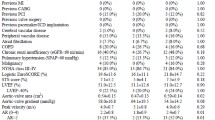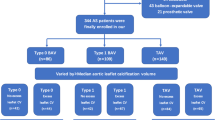Abstract
Objectives
To define the incidence of high residual gradient (HRG) after transcatheter aortic valve replacement (TAVR) in BAVs and their impact on short term outcome and 1-year mortality.
Background
Transcatheter heart valves (THVs) offer good performance in tricuspid aortic valves with low rate of HRG. However, data regarding their performance in bicuspid aortic valves (BAV) are still lacking.
Methods
The BEAT (Balloon vs Self-Expandable valve for the treatment of bicuspid Aortic valve sTenosis) registry included 353 consecutive patients who underwent TAVR (Evolut R/PRO or Sapien 3 valves) in BAV between June 2013 and October 2018. The primary endpoint was device unsuccess with post-procedural HRG (mean gradient ≥ 20 mmHg). The secondary endpoint was to identify the predictors of HRG following the procedure.
Results
Twenty patients (5.6%) showed HRG after TAVR. Patients with HRG presented higher body mass index (BMI) (30.7 ± 9.3 vs. 25.9 ± 4.8; p < 0.0001) and higher baseline aortic mean gradients (57.6 ± 13.4 mmHg vs. 47.7 ± 16.6, p = 0.013) and more often presented with BAV of Sievers type 0 than patients without HRG. At multivariate analysis, BMI [odds ratio (OR) 1.12; 95% confidence interval (CI) 1.05–1.20, p = 0.001] and BAV type 0 (OR 11.31, 95% CI 3.45–37.06, p < 0.0001) were confirmed as independent predictors of high gradient.
Conclusion
HRG following TAVR in BAVs is not negligible and is higher among patients with high BMI and with BAV 0 anatomy.
Graphic abstract




Similar content being viewed by others
Change history
23 March 2021
A Correction to this paper has been published: https://doi.org/10.1007/s00392-021-01824-z
Abbreviations
- HRG:
-
High residual gradient
- THV:
-
Transcatheter heart valve
- TAVI:
-
Transcatheter aortic valve implantation
- TAVR:
-
Transcatheter aortic valve replacement
- BAV:
-
Bicuspid aortic valves
- VARC:
-
Valve Academic Research Consortium
- BMI:
-
Body mass index
- OR:
-
Odds ratio
- CI:
-
Confidence interval
- PAR:
-
Paravalvular aortic regurgitation
References
Mack MJ, Leon MB, Thourani VH et al (2019) Transcatheter aortic-valve replacement with a balloon-expandable valve in low-risk patients. N Engl J Med 380(18):1695–1705
Leon MB, Smith CR, Mack MJ et al (2016) Transcatheter or surgical aortic-valve replacement in intermediate-risk patients. N Engl J Med 374:1609–1620
Leon MB, Smith CR, Mack M et al (2010) Transcatheter aortic-valve implantation for aortic stenosis in patients who cannot undergo surgery. N Engl J Med 363(17):1597–1607
Kawamori H, Yoon SH, Chakravarty T et al (2018) Computed tomography characteristics of the aortic valve and the geometry of SAPIEN 3 transcatheter heart valve in patients with bicuspid aortic valve disease. Eur Heart J Cardiovasc Imaging 19(12):1408–1418
Sievers HH, Schmidtke C (2007) A classification system for the bicuspid aortic valve from 304 surgical specimens. J ThoracCardiovascSurg 133(5):1226–1233
Kappetein AP, Head SJ, Généreux P et al (2012) Updated standardized endpoint definitions for transcatheter aortic valve implantation: the Valve Academic Research Consortium-2 consensus document. Eur Heart J 33(19):2403–2418
Kappetein AP, Head SJ, Généreux P et al (2013) Updated standardized endpoint definitions for transcatheter aortic valve implantation: the Valve Academic Research Consortium-2 consensus document. J ThoracCardiovascSurg 145(1):6–23
Mangieri A, Chieffo A, Won-Keun W et al (2018) Transcatheter aortic valve implantation using the ACURATE neo in bicuspid and tricuspid aortic valve stenosis: a propensity-matched analysis of a European experience. EuroIntervention 14(12):e1269–e1275
Halim SA, Edwards FH, Dai D et al (2020) Outcomes of transcatheter aortic valve replacement in patients with bicuspid aortic valve disease: a report from the Society of Thoracic Surgeons/American College of Cardiology Transcatheter Valve Therapy Registry. Circulation 141(13):1071–1079
Del Trigo M, Muñoz-Garcia AJ, Wijeysundera HCM et al (2016) Incidence, timing, and predictors of valve hemodynamic deterioration after transcatheter aortic valve replacement multicenter registry. J Am Coll Cardiol 67(6):644–655
Yousef A, Simard T, Webb JA et al (2015) Transcatheter aortic valve implantation in patients with bicuspid aortic valve: a patient level multi-center analysis. Int J Cardiol 189:282–288
Yoon SH, Bleiziffer S, De Backer O et al (2017) Outcomes in transcatheter aortic valve replacement for bicuspid versus tricuspid aortic valve stenosis. J Am Coll Cardiol 69(21):2579–2589
Freitas-Ferraz AB, Tirado-Conte G, Dagenais F et al (2019) Aortic stenosis and small aortic annulus. Circulation 139(23):2685–2702
Miyasaka M, Tada N, Taguri M, OCEAN-TAVI Investigators et al (2018) Incidence, predictors, and clinical impact of prosthesis-patient mismatch following transcatheter aortic valve replacement in asian patients: the OCEAN-TAVI registry. J Am Coll CardiolIntv 11(8):771–780
Fallon JM, DeSimone JP, Brennan JM et al (2018) The incidence and consequence of prosthesis-patient mismatch after surgical aortic valve replacement. Ann ThoracSurg 106(1):14–22
Martin C, Sun W (2017) Transcatheter valve underexpansion limits leaflet durability: implications for valve-in-valve procedures. Ann Biomed Eng 45(2):394–404
Funding
This research did not receive any specific grant from funding agencies in the public, commercial, or not-for-profit sectors.
Author information
Authors and Affiliations
Corresponding author
Ethics declarations
Conflict of interest
The authors declare that they have no conflict of interest.
Ethical approval
This is an observational study and was conducted from data obtained for clinical purposes. The BEAT (Balloon vs Self-Expandable valve for the treatment of bicuspid Aortic valve sTenosis) registry has been approved by local Ethical Committee.
Informed consent
Informed consent was obtained from all individual participants included in the study.
Additional information
The original online version of this article was revised: The original version of this article, published on January 3, 2021, contained a mistake. The spelling of Arif Khokhar’s name was incorrect. The original article has been corrected.
Rights and permissions
About this article
Cite this article
Bugani, G., Pagnesi, M., Tchetchè, D. et al. Predictors of high residual gradient after transcatheter aortic valve replacement in bicuspid aortic valve stenosis. Clin Res Cardiol 110, 667–675 (2021). https://doi.org/10.1007/s00392-020-01793-9
Received:
Accepted:
Published:
Issue Date:
DOI: https://doi.org/10.1007/s00392-020-01793-9




